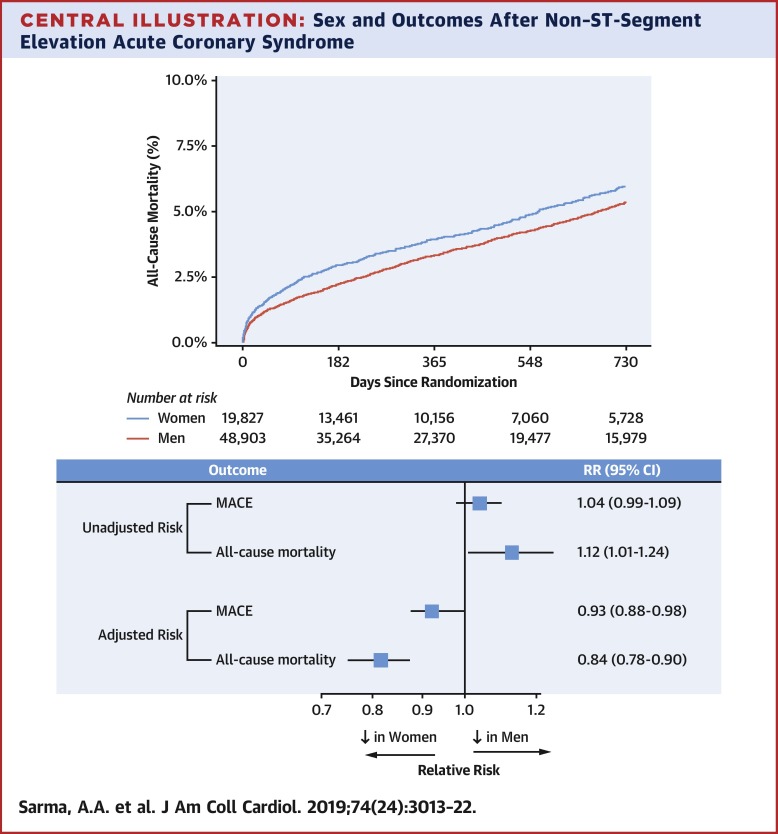当前位置:
X-MOL 学术
›
J. Am. Coll. Cardiol.
›
论文详情
Our official English website, www.x-mol.net, welcomes your feedback! (Note: you will need to create a separate account there.)
Outcomes of Women Compared With Men After Non–ST-Segment Elevation Acute Coronary Syndromes
Journal of the American College of Cardiology ( IF 24.0 ) Pub Date : 2019-12-01 , DOI: 10.1016/j.jacc.2019.09.065 Amy A Sarma 1 , Eugene Braunwald 2 , Christopher P Cannon 3 , Jianping Guo 2 , KyungAh Im 2 , Elliott M Antman 2 , C Michael Gibson 4 , L Kristin Newby 5 , Robert P Giugliano 2 , David A Morrow 2 , Stephen D Wiviott 2 , Marc S Sabatine 2 , Michelle L O'Donoghue 2
Journal of the American College of Cardiology ( IF 24.0 ) Pub Date : 2019-12-01 , DOI: 10.1016/j.jacc.2019.09.065 Amy A Sarma 1 , Eugene Braunwald 2 , Christopher P Cannon 3 , Jianping Guo 2 , KyungAh Im 2 , Elliott M Antman 2 , C Michael Gibson 4 , L Kristin Newby 5 , Robert P Giugliano 2 , David A Morrow 2 , Stephen D Wiviott 2 , Marc S Sabatine 2 , Michelle L O'Donoghue 2
Affiliation

|
BACKGROUND
It remains disputed whether women are at excess risk of adverse outcomes versus men after non-ST-segment elevation acute coronary syndromes (NSTEACS) or whether differences are explained by discordant risk factors. OBJECTIVES
A sex-specific analysis of cardiovascular outcomes after NSTEACS across trials conducted by the Thrombolysis In Myocardial Infarction (TIMI) Study Group was performed to determine the impact of sex on cardiovascular outcomes in this dataset. METHODS
Ten TIMI trials were identified that enrolled >2,500 patients with NSTEACS within 30 days of hospitalization. Cox proportional hazards models were used to examine the association of sex with major adverse cardiovascular events (MACE) (cardiovascular death, myocardial infarction, or stroke) after adjusting for relevant risk factors in individual trials; point estimates were then combined by using random effects models. Individual components of the composite outcome and all-cause mortality were also analyzed. RESULTS
Among 68,730 patients with NSTEACS, 19,827 (29%) were women. Women were older and more frequently had hypertension, diabetes, prior heart failure, and renal impairment than men. Before considering relevant confounders, women were at similar risk of MACE compared with men (hazard ratio [HR]: 1.04; 95% confidence interval [CI]: 0.99 to 1.09; p = 0.16) but at higher risk of all-cause death (HR: 1.12; 95% CI: 1.01 to 1.24; p = 0.03). After adjustment for baseline differences, risks of MACE (HR: 0.93; 95% CI: 0.88 to 0.98; p < 0.01) and all-cause death (HR: 0.84; 95% CI: 0.78 to 0.90; p < 0.0001) were lower among women compared with men. CONCLUSIONS
After accounting for cardiovascular risk factors, women enrolled in clinical trials were at lower risk of MACE than men after NSTEACS. Women, however, remain undertreated with many evidence-based therapies.
中文翻译:

非 ST 段抬高急性冠状动脉综合征后女性与男性的结局比较
背景 在非 ST 段抬高型急性冠脉综合征 (NSTEACS) 后,女性是否比男性更容易出现不良结局,或者差异是否由不一致的风险因素解释,这一点仍然存在争议。目的 在心肌梗死溶栓 (TIMI) 研究组进行的试验中,对 NSTEACS 后心血管结局进行了性别特异性分析,以确定性别对该数据集中心血管结局的影响。方法 确定了 10 项 TIMI 试验,在住院 30 天内招募了超过 2,500 名 NSTEACS 患者。在个别试验中调整相关危险因素后,使用 Cox 比例风险模型检查性别与主要不良心血管事件 (MACE)(心血管死亡、心肌梗死或中风)的关联;然后通过使用随机效应模型组合点估计。还分析了复合结果的各个组成部分和全因死亡率。结果 在 68,730 名 NSTEACS 患者中,19,827 (29%) 名是女性。与男性相比,女性年龄更大,更常患有高血压、糖尿病、既往心力衰竭和肾功能损害。在考虑相关混杂因素之前,女性与男性相比发生 MACE 的风险相似(风险比 [HR]:1.04;95% 置信区间 [CI]:0.99 至 1.09;p = 0.16),但全因死亡风险更高( HR:1.12;95% CI:1.01 至 1.24;p = 0.03)。调整基线差异后,MACE(HR:0.93;95% CI:0.88 至 0.98;p < 0.01)和全因死亡(HR:0.84;95% CI:0.78 至 0.90;p < 0.0001)的风险较低女性与男性相比。结论 在考虑心血管危险因素后,参加临床试验的女性在 NSTEACS 后发生 MACE 的风险低于男性。然而,许多循证疗法对女性的治疗仍然不足。
更新日期:2019-12-01
中文翻译:

非 ST 段抬高急性冠状动脉综合征后女性与男性的结局比较
背景 在非 ST 段抬高型急性冠脉综合征 (NSTEACS) 后,女性是否比男性更容易出现不良结局,或者差异是否由不一致的风险因素解释,这一点仍然存在争议。目的 在心肌梗死溶栓 (TIMI) 研究组进行的试验中,对 NSTEACS 后心血管结局进行了性别特异性分析,以确定性别对该数据集中心血管结局的影响。方法 确定了 10 项 TIMI 试验,在住院 30 天内招募了超过 2,500 名 NSTEACS 患者。在个别试验中调整相关危险因素后,使用 Cox 比例风险模型检查性别与主要不良心血管事件 (MACE)(心血管死亡、心肌梗死或中风)的关联;然后通过使用随机效应模型组合点估计。还分析了复合结果的各个组成部分和全因死亡率。结果 在 68,730 名 NSTEACS 患者中,19,827 (29%) 名是女性。与男性相比,女性年龄更大,更常患有高血压、糖尿病、既往心力衰竭和肾功能损害。在考虑相关混杂因素之前,女性与男性相比发生 MACE 的风险相似(风险比 [HR]:1.04;95% 置信区间 [CI]:0.99 至 1.09;p = 0.16),但全因死亡风险更高( HR:1.12;95% CI:1.01 至 1.24;p = 0.03)。调整基线差异后,MACE(HR:0.93;95% CI:0.88 至 0.98;p < 0.01)和全因死亡(HR:0.84;95% CI:0.78 至 0.90;p < 0.0001)的风险较低女性与男性相比。结论 在考虑心血管危险因素后,参加临床试验的女性在 NSTEACS 后发生 MACE 的风险低于男性。然而,许多循证疗法对女性的治疗仍然不足。



























 京公网安备 11010802027423号
京公网安备 11010802027423号